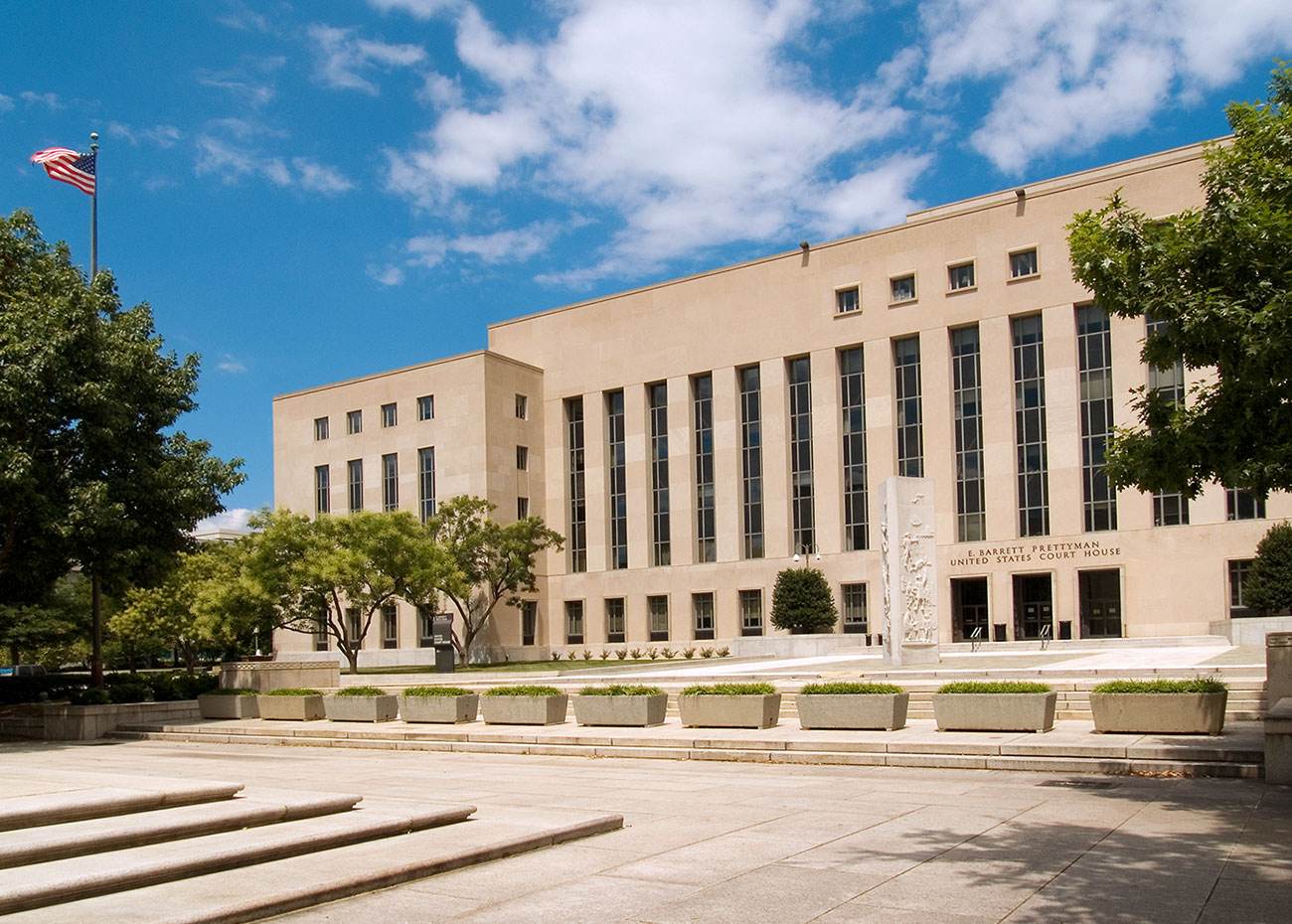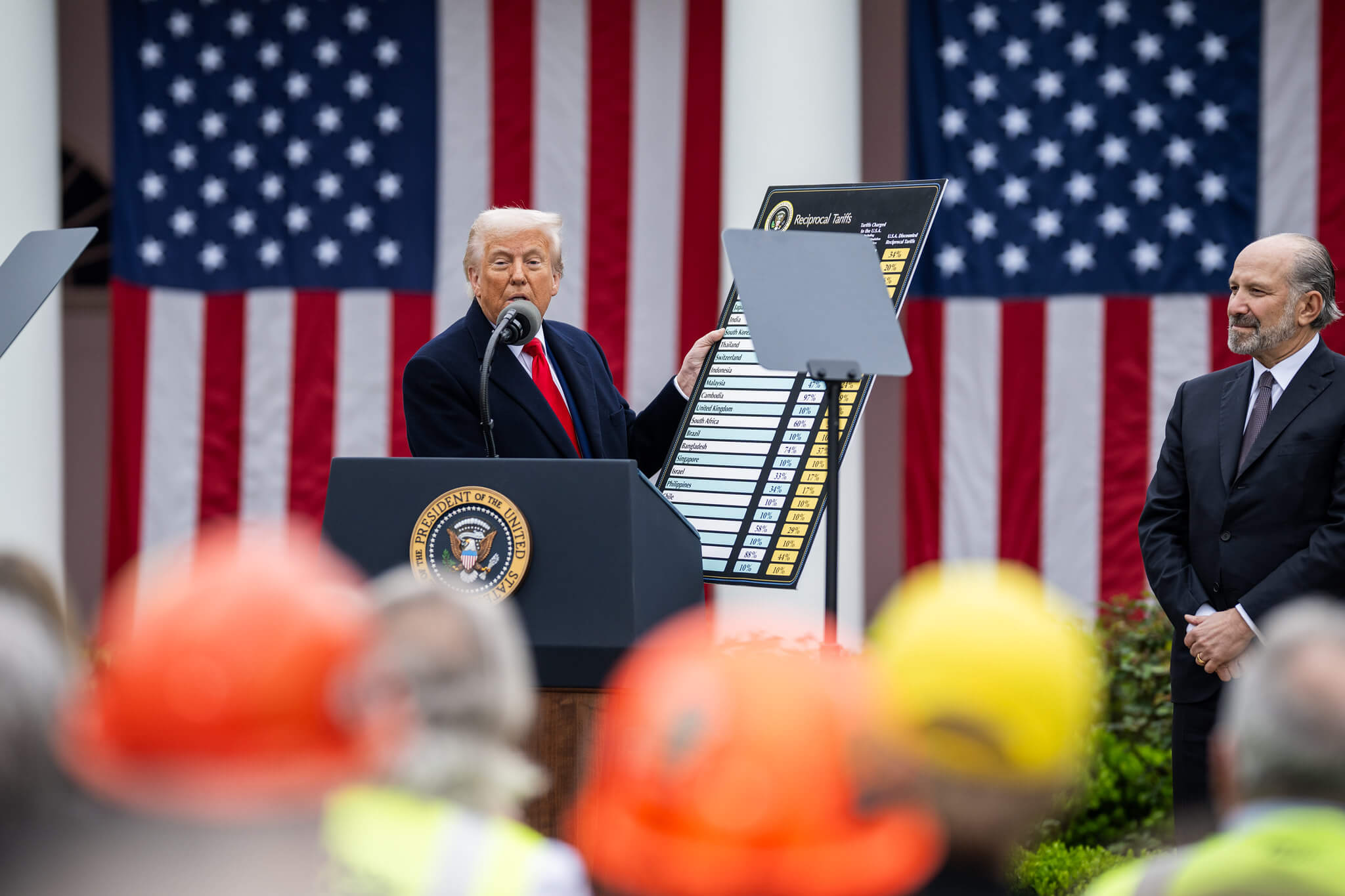The D.C. Circuit Has Quietly Set the Rules for Dismantling Government

Published by The Lawfare Institute
in Cooperation With

Over the past two weeks, the U.S. Court of Appeals for the District of Columbia Circuit has set out the parameters it will be using to review the legality of the Trump administration’s unprecedented effort to dismantle federal agencies and terminate federal spending and employees. It’s a potentially major development that has been mostly overlooked, in large part because the court’s position—arrived at while sitting en banc in review of several related disputes relating to the U.S. Agency for Global Media—is spread across several short statements rife with internal cross-references. Piecing it together, however, sheds light on the lens through which the influential appellate court is likely to view some of the most dramatic elements of the Trump administration’s deregulatory agenda—at least until the Supreme Court tells them otherwise.
Deciphering Widakuswara v. Lake
The cases in question began with President Trump’s March 14 executive order directing that the “non-statutory components and functions” of the U.S. Agency for Global Media, among certain other agencies, “be eliminated to the maximum extent consistent with applicable law” and that agency officials “reduce the performance of their statutory functions and associated personnel to the minimum presence and function required.” Several groups of plaintiffs quickly challenged these actions, including two relating to the termination of Voice of America employees and contractors as well as the cancellation of related grants—Widakuswara v. Lake and Abramowitz v. Lake—and three others relating to affiliated regional outlets—the Middle East Broadcasting Network v. United States, Radio Free Asia v. United States, and Radio Free Europe/Radio Liberty, Inc. v. Lake—reliant on congressionally appropriated grant funds that Trump’s directive had cut off. While some were initially filed elsewhere, all five cases ultimately found themselves before Judge Royce Lamberth in federal district court in Washington, D.C.
In late April, after extensive briefing by the parties, Lamberth granted the plaintiffs’ various motions for preliminary injunctions across the five cases. The exact relief varied across matters, but Lamberth generally directed the government to take three steps (presented most squarely in his order in Widakuswara): to (1) “return … employees and contractors to their status prior to” the March 14 executive order; (2) “restore … grants” of funds appropriated for the regional affiliates by Congress, so that they can meet their statutory mandate to “provide news which is consistently reliable and authoritative, accurate, objective, and comprehensive”; and (3) “restore [Voice of America] programming” so as to fulfill the statutory mandate that it “serve as a consistently reliable and authoritative source of news[.]”
The government quickly appealed prongs (1) and (2) of Lamberth’s order to the D.C. Circuit, while declining to challenge (3) on the grounds that the Trump administration intended to maintain the agency’s statutory minimum level of operation. Considering the matters together under the caption of Widakuswara v. Lake, two members of a three-judge D.C. Circuit panel—Judges Gregory G. Katsas and Neomi Rao, both Trump appointees—granted the government’s request for a stay of Lamberth’s preliminary injunctions on May 1, over a dissent by Judge Cornelia T.L. Pillard, an Obama appointee. In doing so, Katsas and Rao—writing as a per curiam—embraced the arguments that Justice Department lawyers have deployed in defense of the Trump administration’s actions across the country: that federal district court judges like Lamberth lacked the jurisdiction necessary to issue any relief as, under various civil service statutes, federal employees and contractors had to bring their employment challenges through the Merit Systems Protection Board and similar bodies while, under the Tucker Act, challenges to funding cut-offs had to be brought before the Court of Federal Claims. Neither procedure readily allows for preliminary injunctive relief, however, meaning that the Trump administration’s actions would likely stand even as their legality would continue to be litigated.
The plaintiffs almost immediately sought review by the en banc D.C. Circuit, which—in contrast to the panel’s Trump-appointed majority—consists of almost twice as many Democratic as Republican appointees. In a highly uncharacteristic move, the D.C. Circuit quickly issued a May 7 temporary administrative stay of the panel’s opinion while it considered the plaintiffs’ request, prompting a dissent by Katsas that was joined by the en banc court’s three other Republican appointees. This administrative stay, however, applied only to prong (2) of Lamberth’s original order, relating to halts in funding. This appeared to be bad news for Voice of America employees and contractors, as it left the requirement that they be maintained at or restored to their pre-March 14 employment status—contained in prong (1) of Lamberth’s preliminary injunction—stayed by the D.C. Circuit panel and thus inoperative. The en banc D.C. Circuit seemed to confirm as much on May 22 when it officially denied the plaintiffs’ appeal of the panel’s opinion in regard to prong (1) without explanation, noting only that “[s]tatements concerning this order will follow at a later time.” In the meantime, the Trump administration fired 600 of Voice of America’s contractors and reportedly started moving forward with plans to terminate nearly all of its remaining employees.
Yet when the en banc D.C. Circuit finally announced its decision on the plaintiffs’ motion for en banc reconsideration on May 28, it was not quite what one might have expected.
Challenges to Withheld Federal Funds
On the outstanding question regarding the stay on prong (2) of Lamberth’s preliminary injunctions relating to funding, the en banc D.C. Circuit granted the motion, vacated the panel’s opinion, and indicated it would hear further argument on the merits of the issue. In so doing, it noted that, while the government’s jurisdictional argument “raises an important issue,” a majority of the court’s judges found it too unlikely to succeed on the merits to maintain the panel’s stay of the district court’s preliminary injunction, citing to Pillard’s prior dissent to the stay granted by the panel. The en banc court also noted that the government had not contested the funding-related plaintiffs’ claims of irreparable injury, which were rooted in the fact that “suspension of the government’s monthly grant payments to them will promptly and severely threaten their continued viability, rendering them unable to exist except as a formal matter and making it unlikely they could recover even if they ultimately prevail on their claims.” While the government had also argued that it would suffer irreparable harm absent a stay as such payments would be impossible to recover, the court concluded that “the government has not shown that the equities weigh in favor of a stay pending appeal”—especially as “the government has not contended that it will ultimately prevail in establishing an entitlement to those funds,” but had only advanced a jurisdictional argument.
Katsas objected, in another dissent joined by the court’s three other Republican appointees. Citing back to his prior dissent to the administrative stay—which had largely parroted the government’s arguments as to why such claims had to be channeled to the Court of Federal Claims under the Tucker Act—he emphasized that the en banc court’s conclusion was in tension with the Supreme Court’s recent decision in Department of Education v. California. There the Court had ruled 6-3 that, under the Tucker Act, California and other state governments had to pursue their legal challenges to the Trump administration’s termination of certain education grants through the Court of Federal Claims. The Court took this position, Katsas noted, even though the government had only addressed jurisdiction and not argued the merits of its actions—a seemingly sharp contrast with the en banc D.C. Circuit’s decision.
Yet by endorsing Judge Pillard’s reasoning from her earlier dissent to the panel opinion, the en banc court had already implicitly addressed these arguments. In that dissent, Pillard rejected the conclusion that the plaintiffs’ funding claims were contract actions of the sort normally subject to the Tucker Act simply because they are seeking to compel the disbursement of funds. In her view, the plaintiffs were instead “challeng[ing] the government’s assertion that it may disregard specific congressional funding directives when it disagrees with Congress’s policy choices,” based on “rights aris[ing] from federal statutes and the Constitution … independent of any contract ….” Citing relevant circuit court precedent, Pillard concluded that such claims were properly pursued outside the Tucker Act. Moreover, under the Supreme Court’s holding in Bowen v. Massachusetts, the remedy the plaintiffs were seeking was “the disgorgement of funds owed” as a “matter of statutory entitlement,” not “compensatory relief” in the form of “monetary damages” of the sort usually covered by the Tucker Act.
Pillard also addressed the implications of the Supreme Court’s holding in Department of Education v. California, which she distinguished on the grounds that the grants whose cancellation was being challenged there were discretionary grants made by the executive branch, not the products of statutory entitlement. Instead, she concluded that the present cases were closer to the Supreme Court’s earlier holding in Department of State v. AIDS Vaccine Advocacy Coalition, where plaintiffs similarly advanced constitutional and statutory challenges to the mass cancellation of foreign assistance funds that they would otherwise have received. There, a 5-4 Court allowed a federal district court’s preliminary injunctive relief to stand, despite both the government and the four dissenting justices advancing similar arguments that it did not have the jurisdiction to provide for such relief under the Tucker Act. In addition, Pillard noted that the plaintiffs in Department of Education v. California had not argued that they would collapse or otherwise suffer major irreparable harm absent preliminary injunctive relief, unlike some of the plaintiffs in AIDS Vaccine Advocacy Coalition and the funding plaintiffs in Widakuswara and related cases.
The court was careful to note that “[t]his order of course does not constrain the ability of the panel that hears the government’s appeals to reach any conclusion following full merits briefing and argument[,]” meaning its analysis of the government’s jurisdictional argument remains preliminary. But the fact that a majority of the en banc court felt comfortable vacating the panel opinion’s stay on prong (2) “substantially for the reasons explained by Judge Pillard” in her earlier dissent is the clearest sign to date that those arguments are likely to fall short within the D.C. Circuit as a whole.
Challenges to Agency Employment Actions
Meanwhile, in a separate May 28 filing, the en banc D.C. Circuit also provided the statements it promised in its May 22 order denying reconsideration en banc of the panel’s stay of prong (1) of Lamberth’s preliminary injunctions relating to employees and contractors. Together, they had the effect of dramatically changing what many assumed to be the implications of the en banc court’s denial of reconsideration.
In a brief explanatory statement joined by the six other nondissenting (and Democrat-appointed) judges—a majority of the en banc court—Chief Judge Sri Srinivasan emphasized that, while the court was allowing prong (1) to remain stayed, prong (3) “remains unstayed” and “requires the government to restore [Voice of America] programming so as to fulfill [its] statutory mandate.” While the Trump administration had asserted that the district court lacks any authority to determine what personnel actions are necessary to fulfill that statutory mandate, Srinivasan cast shade on this proposition, observing that “[t]he court’s denial of en banc reconsideration … should not be understood to accept … the government’s assertion in that regard.” Instead, “insofar as the issue may arise in further proceedings in the district court,” Srinivasan maintained that it would be up to the district court to consider the relevance of personnel actions to the obligation to fulfill Voice of America’s statutory mandate “in the first instance.”
In a separate statement, Pillard elaborated on what exactly this could mean in practice, particularly as it relates to the Voice of America employees and contractors no longer protected by prong (1) of Lamberth’s preliminary injunctions. After defending Lamberth’s approach and reiterating that she would not have stayed prong (1) per her earlier dissent, she implied that a majority of the en banc court was not comfortable vacating the panel’s conclusion that “defendants [were] likely to succeed on jurisdictional grounds.” This suggests that, at least at this preliminary stage, a majority of the en banc court was inclined to agree that employment challenges of the type addressed by prong (1) should generally be channeled to the Merit Systems Protection Board and other specialized bodies.
Yet Pillard concluded by observing that “this court has not limited the district court’s remedial options going forward,” including its “power to require the agency’s compliance with its statutory obligations” and to “modify the preliminary injunction as circumstances develop, even while the appeal of the preliminary injunction is pending.” And while she acknowledged that the government had “repeatedly emphasized its broad discretion to determine what levels of staffing are necessary” to fulfill its statutory mandate, she doubled down on Srinivasan’s cautionary note, observing that such discretion “is neither boundless nor shielded from judicial review and mediation.”
While never quite stated expressly, the clear takeaway from these statements is that Lamberth may still be able to restrict the Trump administration’s ability to terminate employers or contractors where doing so is necessary to ensure compliance with Voice of America’s statutory mandate. This is likely to require something more tailored than the blanket injunction on termination in the original prong (1) of his prior preliminary injunctions, especially as the en banc D.C. Circuit believes he likely lacks jurisdiction over employment decisions not linked to a statutory directive. And the government may well be entitled to some degree of deference in such staffing decisions, though not the categorical deference that the majority of the en banc court expressly declined to endorse and Pillard outright rejected. But if Lamberth concludes that the Trump administration’s staffing cuts will compromise Voice of America’s ability to meet its statutory obligations, a majority of the en banc D.C. Circuit seems to believe that he remains within his authority to enjoin the government from pursuing them on that grounds.
Broader Implications
The significance of the en banc D.C. Circuit’s recent statements extends well beyond Widakuswara and the related U.S. Agency for Global Media cases. As the federal appellate court with jurisdiction over the broadest swathe of the federal government, the D.C. Circuit will have a substantial say in a disproportionate share of the legal challenges relating to the Trump administration’s dismantling of federal agencies. And while court norms have historically disfavored doing so outside of exceptional cases, the en banc D.C. Circuit can—and, in recent weeks, has proved willing to—vacate and reconsider any decision by an individual three-judge panel with which it does not agree upon request. In this, Widakuswara is the clearest indicator yet of how the penultimate legal authority—final unless overruled by the Supreme Court—is likely to approach a great number of the legal challenges to the Trump administration’s actions still pending in D.C. federal district courts.
For challenges to the Trump administration’s federal funding cuts, a majority of the en banc D.C. Circuit seems poised to reject the government’s argument that the Tucker Act requires that such claims be pursued through the Court of Federal Claims, at least where the plaintiffs argue that the Trump administration is acting contrary to some constitutional and statutory obligation. The court may reach a different conclusion in cases where a plaintiff’s challenge is rooted solely in their contract with the federal government, in line with how a majority of judges read the Supreme Court’s holding in California v. Department of Education. But many of the challenges to the Trump administration’s funding terminations are rooted in constitutional and statutory law—most commonly, that the administration is unlawfully impounding funds by refusing to use them in the manner for which Congress duly appropriated them. Hence the D.C. Circuit seems likely to conclude that federal district courts have the jurisdiction necessary to both provide preliminary injunctive relief and resolve the underlying dispute on the merits. That said, this is the issue that the en banc D.C. Circuit has agreed to reconsider, and it may yet reach a contrary conclusion after briefing and oral arguments later this month.
By contrast, the en banc D.C. Circuit seems willing to accept that federal district courts generally lack jurisdiction over direct challenges to the merits of federal personnel actions, which must instead be brought before the Merit Systems Protection Board and other specialized bodies. Yet this presumption shifts where a legal challenge is addressed not toward the grounds for a given personnel action itself, but toward the impact it has on an agency’s ability to fulfill its statutory functions. In other words, where plaintiffs show that an agency is pursuing personnel actions that will undermine its ability to meet its statutory obligations, a federal district court has the jurisdiction necessary to issue a preliminary injunction and ultimately reach the merits. The only question—though it remains quite substantial—is how the district court determines what personnel levels are appropriate and how much deference it is obligated to give the views of the executive branch.
If this posture sounds familiar, that’s because it is almost exactly where the D.C. Circuit arrived in National Treasury Employees’ Union v. Vought, the lead challenge to the dismantling of the Consumer Financial Protection Bureau (CFPB) and termination of its workforce. After Judge Amy Berman Jackson initially enjoined the CFPB leadership from pursuing large-scale reductions in force, the same three-judge panel that sat in Widakuswara unanimously agreed to a stay that would allow the CFPB to terminate employees who they determined, “after a particularized assessment, to be unnecessary to the performance of [its] statutory duties.” Seemingly viewing this as a green light, the Trump administration issued termination notices to the vast majority of CFPB’s staff just days after the panel’s opinion came down. But this triggered another order from Jackson suspending the reductions in force while she conducted fact-finding into whether the CFPB had actually done the “particularized assessment” required. After the government sought another stay in an effort to avoid having CFPB leadership give testimony regarding their decision-making process, Katsas and Pillard—over a dissent by Rao, who argued that the district court was exercising undue control over an executive agency’s operations—decided sua sponte to lift their original stay and restore Jackson’s injunction on reductions in force pending the panel’s decision on the government’s appeal, which remains outstanding.
Now a majority of the en banc D.C. Circuit has suggested that Jackson was on the right track in examining whether the CFPB’s rapid termination of the vast majority of its staff would interfere with its ability to fulfill its statutory mandate. And if the Trump administration moves forward with its reported plan to similarly gut the Voice of America, they may find themselves facing a renewed injunction and similar fact-finding from Judge Lamberth.
Underlying both the funding and personnel elements of the en banc D.C. Circuit’s approach in Widakuswara is a common constitutional understanding: that Congress’s directions—at least where enacted into statute—matter when it comes to the operations of federal agencies. While the president undoubtedly has substantial constitutional authority to manage and direct the executive branch, the court does not view this as superseding his duty to “take Care that the Laws be faithfully executed” nor Congress’s authority to appropriate funds, set the rules for federal employment, or otherwise determine an agency’s structure and functions.
This understanding has ramifications far beyond the employment and funding contexts, the enforcement of which will only get more difficult. At some point, Judge Lamberth or one of his colleagues will have to evaluate whether the Trump administration’s plans for the operation of Voice of America—which currently consists of rebroadcasting the far-right, Trump-aligned One America News network—is consistent with Congress’s direction that it “serve as a consistently reliable and authoritative source of news” that is “accurate, objective, and comprehensive.” Or whether the CFPB is truly “collecting, investigating, and responding to consumer complaints” and “taking appropriate enforcement action to address violations of Federal consumer financial law” when it has withdrawn the vast majority of its enforcement actions and guidance. Or whether folding foreign assistance functions into the Department of State is consistent with the requirement that “there [be] within the Executive branch of Government the United States Agency for International Development.”
Addressing these questions will require the federal courts to engage in not just fact-specific but value-laden inquiry on matters that have a direct bearing on the sorts of policy choices entrusted to the political branches of government. This is no doubt why at least some of the conservative judges (most notably Rao) have expressed discomfort with the courts playing such a role—and why federal courts have traditionally given the executive branch a fair degree of deference in how such statutes are understood. But embracing the near-absolute deference Rao urges risks neutering Congress’s past enactments altogether, especially in the face of the Trump administration’s aggressive approach to executive power, which has seen it push the executive branch’s interpretation of various statutes up to and beyond the limits of credulity. Perhaps for this reason, a majority of the en banc D.C. Circuit seems prepared to allow district court judges to engage in the difficult task of investigating whether the Trump administration is truly acting within the permissible outer confines of the rules that Congress has set out for it.
Of course, the en banc D.C. Circuit’s approach will matter only so long as it is not overruled by the Supreme Court. And one might reasonably expect the conservative Supreme Court—a third of which Trump appointed—to be far friendlier terrain to the president’s agenda than the majority Democrat-appointed en banc D.C. Circuit. Yet it’s been less than a year since the same Court’s landmark decision in Loper Bright Enterprises v. Raimondo, wherein it narrowed the deference that had previously been given to the executive branch on the interpretation of statutes. There it held that federal judges have a duty to “construe the law with clear heads and honest hearts, not with an eye to policy preferences that had not made it into the statute[,]” including those of the incumbent president. And while the Court acknowledged concerns about intruding too far into “discretionary policymaking” of the sort constitutionally entrusted to the political branches, it concluded that federal courts could “stay out” of this lane by “fulfill[ing] their obligations under the [Administrative Procedure Act (APA)] to independently identify and respect [congressional] delegations of authority, police the outer statutory boundaries of those delegations, and ensure that agencies exercise their discretion consistent with the APA.”
All told, this reflects a level of judicial scrutiny not far from what the en banc D.C. Circuit appears ready to support. Perhaps the Supreme Court will adopt a different tack when it is faced not with an effort by a Democratic president to act beyond a statutory mandate, but an attempt by a Republican president to ignore and undermine one. And if it does, it will no doubt be seen as further evidence that the Supreme Court’s holding in Loper Bright is what many critics on the left have said it is: pretext for advancing a value-laden deregulatory agenda through the courts that could not pass through Congress. But if, by contrast, the Supreme Court’s holding does reflect a principled approach to statutory interpretation, then the en banc D.C. Circuit’s approach may yet be vindicated as the correct one. Either way, until the Supreme Court says otherwise, it promises more judicial scrutiny of the Trump administration's dismantling of federal agencies—and more injunctions on it moving forward, unless and until the administration can show it is acting consistent with the directions of Congress.





